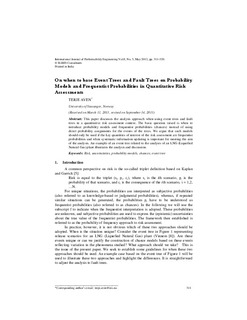| dc.contributor.author | Aven, Terje | |
| dc.date.accessioned | 2013-06-10T12:17:21Z | |
| dc.date.available | 2013-06-10T12:17:21Z | |
| dc.date.issued | 2012 | |
| dc.identifier.citation | Aven, T. (2012) On when to base Event Trees and Fault Trees on Probability Models and Frequentist Probabilities in Quantitative Risk Assessments. International Journal of Performability Engineering. 8(3), pp. 311-320 | no_NO |
| dc.identifier.issn | 0973-1318 | |
| dc.identifier.uri | http://hdl.handle.net/11250/181878 | |
| dc.description.abstract | This paper discusses the analysis approach when using event trees and fault
trees in a quantitative risk assessment context. The basic question raised is when to
introduce probability models and frequentist probabilities (chances) instead of using
direct probability assignments for the events of the trees. We argue that such models
should only be used if the key quantities of interest of the risk assessment are frequentist
probabilities and when systematic information updating is important for meeting the aim
of the analysis. An example of an event tree related to the analysis of an LNG (Liquefied
Natural Gas) plant illustrates the analysis and discussion. | no_NO |
| dc.language.iso | eng | no_NO |
| dc.publisher | Jaipur, India : RAMS Consultants | no_NO |
| dc.subject | risk | no_NO |
| dc.subject | uncertainties | no_NO |
| dc.subject | probability models | no_NO |
| dc.subject | chances | no_NO |
| dc.subject | event tree | no_NO |
| dc.subject | samfunnssikkerhet | no_NO |
| dc.title | On when to base event trees and fault trees on probability models and frequentist probabilities in quantitative risk assessments | no_NO |
| dc.type | Journal article | no_NO |
| dc.type | Peer reviewed | no_NO |
| dc.subject.nsi | VDP::Social science: 200 | no_NO |
| dc.source.pagenumber | 311-320 | no_NO |
| dc.source.volume | 8 | no_NO |
| dc.source.journal | International Journal of Performability Engineering | no_NO |
| dc.source.issue | 3 | no_NO |
